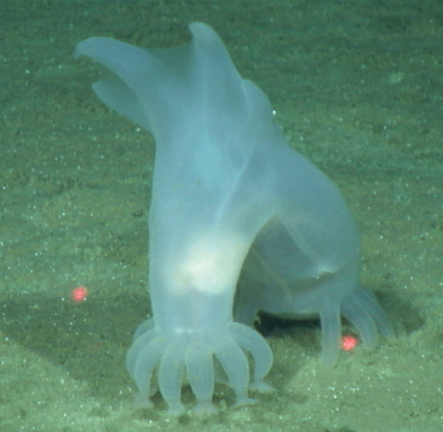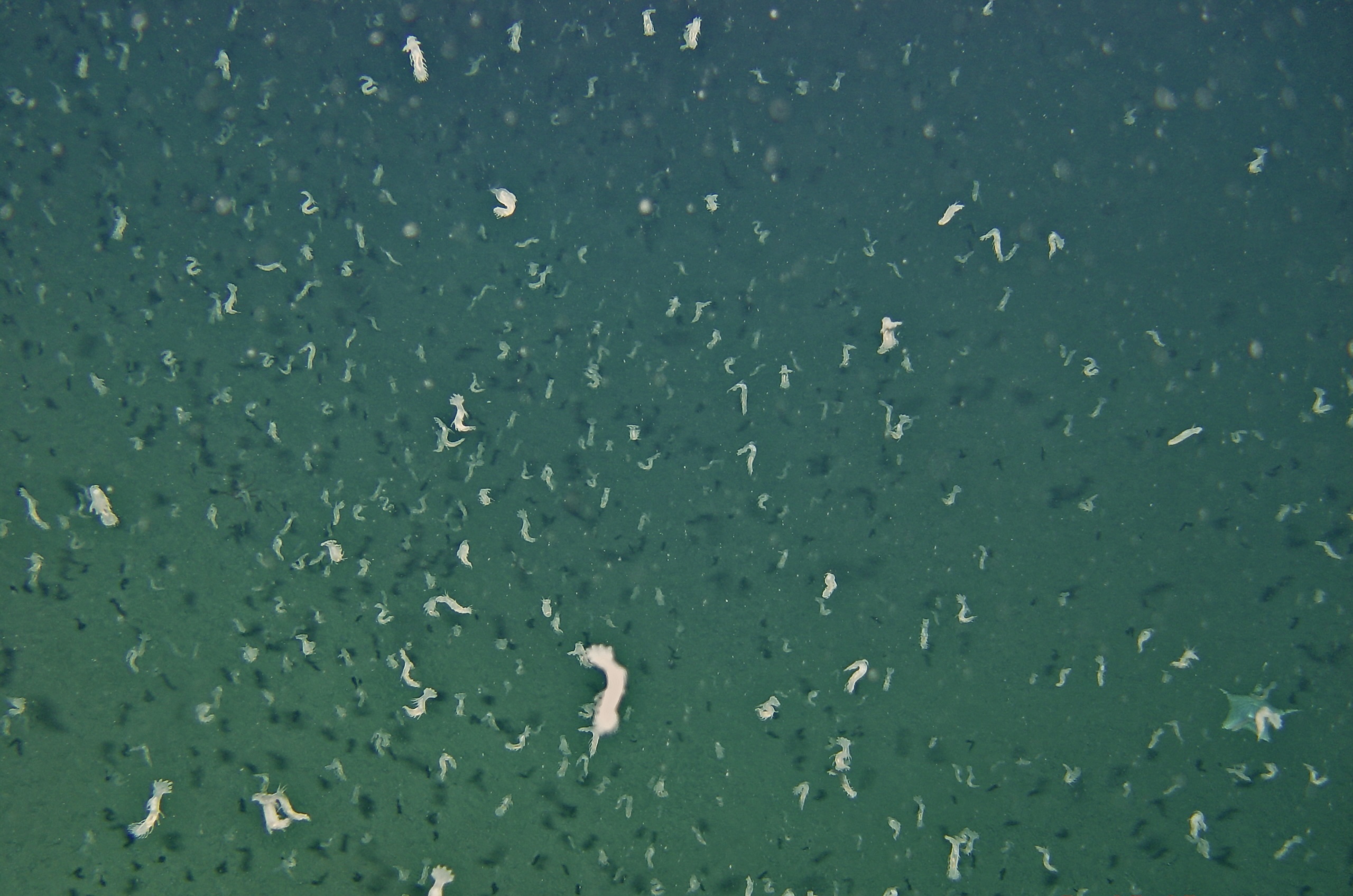At first, the footage could pass for a swath of sky that has suddenly become host to a flock of birds. Doves, perhaps. But soon the camera adjusts to reveal two white stellate shapes. They are too big, too lumpy and organic to be stars in the sky. As the camera drifts closer, they reveal themselves as sea stars, one with arms that taper elegantly, and one with arms that end in rounder stubs: the Bert and Ernie of the seafloor.
At first just a few of the creatures flap slowly through the blue, their bright bodies curling into themselves as they soar. Then the whole fleet appears, too many to easily count, a shifting cloud of swimming sea cucumbers gliding above the murky bottom of the deep sea.
The film is grainy, recorded more than 20 years ago on a dive in the manned submersible Shinkai 6500. One of the scientists aboard the research cruise, Kiichiro Kawamura of Yamaguchi University in Japan, sat on the footage for years, unsure exactly what the video showed. (Kawamura studies marine geology, not sea cucumbers.)
Fast forward to last summer. Chong Chen, a deep-sea biologist at Japan Agency for Marine-Earth Science and Technology, or JAMSTEC, and Akito Ogawa, an invertebrate zoologist at the National Museum of Nature and Science, Tokyo, were involved in a project studying sea cucumbers. Specifically, they were investigating symbiosis in the cucumber's gut. Kawamura, Chen, and Ogawa were about to board a research cruise off Okinawa, where the latter two would search for the cucumbers. "We were hit by a typhoon before the cruise even started," Chen said.
As they waited out the storm, the researchers suddenly had a lot of downtime. They started chatting about sea cucumbers. "Kawamura-san just randomly said, 'Oh, so I have this footage of a lot of sea cucumbers,'" Chen said. When Kawamura showed Chen the video of the flock, "we were were like, 'Oh shit, we've never seen this before. But he's a geologist, so he has no idea."
Chen, to be clear, also does not specialize in sea cucumbers, which, along with sea stars and sand dollars, are animals known as echinoderms. So he immediately consulted Ogawa, the sea cucumber expert. Ogawa, too, was astounded. "I have never known such densely aggregated sea cucumbers, swimming at the same time and [in the] same direction," Ogawa said.
Sea cucumbers, or holothurians, are the most conspicuous creatures in the deep seafloor, except around hydrothermal vents. They trundle around the very bottom of the deepest oceans, churning up sediments as they eat and move around. Scientists have observed vast "herds" of non-swimming sea cucumbers, with up to 50 cucumbers per square meter. "We don't actually know why they aggregate," Chen said. "But this is called the herding behavior."
Some other species of deep-sea sea cucumbers are known to swim. One particularly lovely species, Enypniastes eximia—also known by its aliases the headless chicken monster, the Spanish dancer, the pink see-through fantasia, and the dreamer holothurian—resembles a reddish lantern about as long as a basketball hoop. The dreamer holothurian will swim away if it is disturbed, and typically defecates before taking off from the seafloor, to drop its "ballast." But scientists had only ever observed deep-sea sea cucumbers swimming alone, or alongside a few individuals. They had never witnessed an entire herd taking flight.
When Ogawa studied the footage, he tentatively identified the swimming herd of sea cucumbers as belonging to the genus Peniagone. The way the sea cucumbers moved their bodies resembles the known swimming behavior of Peniagone sea cucumbers. (To identify the actual species would require dissecting the sea cucumbers and examining the hard structures inside their bodies, Chen said.) Peniagone sea cucumbers are more commonly known as sea pigs, as some have pinkish bodies.

The swimming sea cucumbers were sighted by a deep-sea canyon near the city of Omaezaki off Japan's Pacific coast. The researchers speculate they may have crowded together to take advantage of an abundance of food, which may have been transported from land after the monsoon. "After such a heavy rain, some part of the water goes down along the seafloor," offering extra nutrition to the deep, Ogawa said. "Maybe that triggers the sea cucumbers who can swim to gather," Chen said. "If they can swim, maybe that's a more effective way to get around and exploit food that appears sporadically." It's also possible the sea cucumbers flock with the intention of spawning, as spurting sperm and eggs alongside those of hundreds of other seas cucumbers increases the chances of fertilization.
The new paper raises more questions than it answers regarding the mysterious lives of sea cucumbers. "We don't know why they herd, and we don't know why they swim," Chen said. "We don't even know how far they can swim," he added. But scientists do know sea cucumbers are extremely significant animals in the deep sea, in part because of their heft and abundance. They play an important role in geochemical cycling in the deep sea, moving chemicals and microorganisms around in the sludge.
Chen does know one thing for certain: He doesn't like the name "sea cucumber." "It's not a cucumber," he said. "It's not even green. It's not even a plant! Come on!" He prefers namako, the Japanese name for them. It's shorter, easier to say, and does not evoke irrelevant gourds.
It's still unclear how often these dense flocks of blot out the deep blue sea. "We want to know if it is an unusual, very rare case," Ogawa said of the footage of the flock. "And if it is a very rare case, why such a strange situation happened." But it's certainly not a one-time thing. After the paper was published, Ogawa started digging around in JAMSTEC's video database for more examples of the flocking behavior. He's already found several other flocks in the archives, some Peniagone, and others that appear to be of different genera. "There's probably a lot more hidden gems," Chen said.






